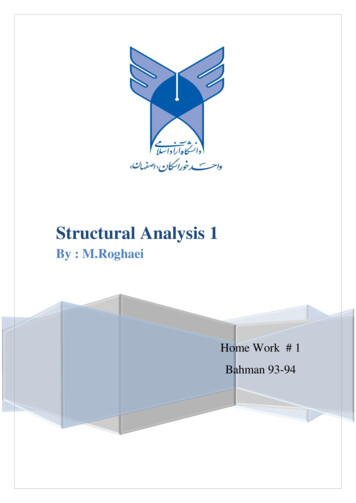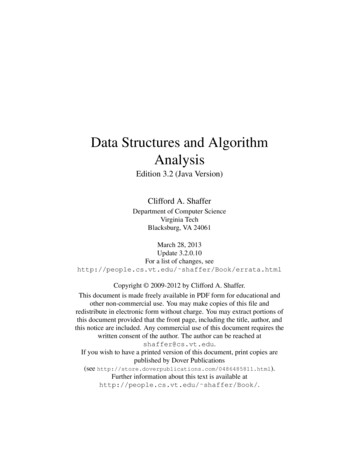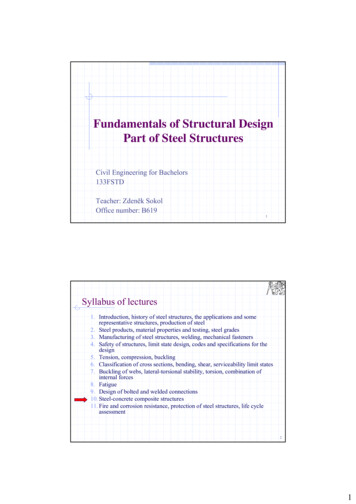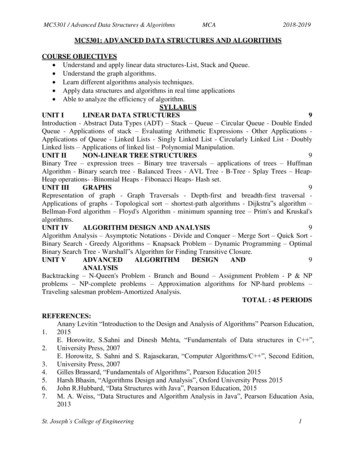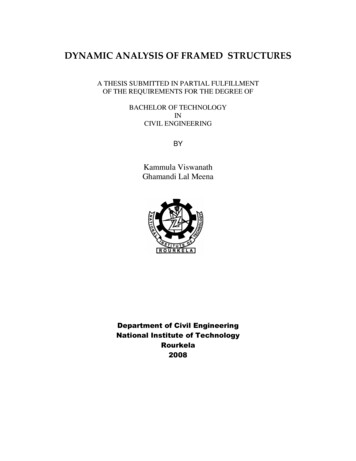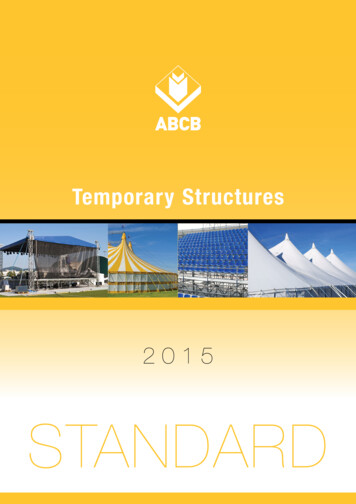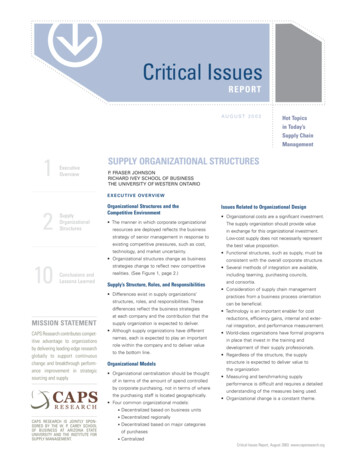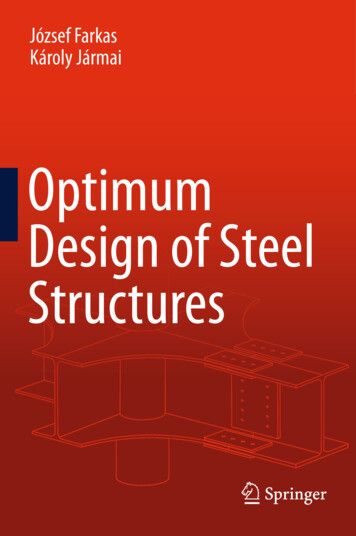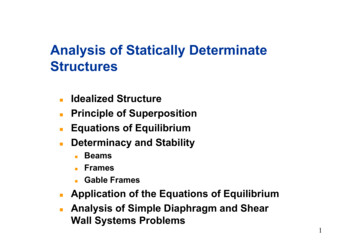
Transcription
Analysis of Statically DeterminateStructures!!!!Idealized StructurePrinciple of SuperpositionEquations of EquilibriumDeterminacy and Stability!!!!!BeamsFramesGable FramesApplication of the Equations of EquilibriumAnalysis of Simple Diaphragm and ShearWall Systems Problems1
Classification of Structures Support Connectionsweldstiffenersweldtypical “pin-supported”connection (metal)typical “roller-supported”connection (concrete)typical “fixed-supported”connection (metal)typical “fixed-supported”connection (concrete)2
pin supportpin-connected jointfixed-connected jointtorsional spring supportfixed supporttorsional spring jointPPABL/2actual beamL/2BAL/2L/2idealized beam3
Table 2-1 Supports for Coplanar StructuresType ctionNumber of UnknownsOne unknown. The reaction is aforce that acts in the direction ofthe cable or link.θOne unknown. The reaction is aforce that acts perpendicular tothe surface at the point of contact.rollersFrockers(3)F(4)FOne unknown. The reaction is aforce that acts perpendicular tothe surface at the point of contact.One unknown. The reaction is aforce that acts perpendicular tothe surface at the point of contact.4
Type ofConnectionIdealizedSymbolReaction(5)FyFxNumber of UnknownsTwo unknowns. The reactionsare two force components.Smooth pin or hinge(6)sliderFMTwo unknowns. The reactionsare a force and moment.fixed-connected collar(7)Fxfixed supportMFyThree unknowns. The reactionsare the moment and the two forcecomponents.5
Idealized Structure.3mB3mBF4mFAactual structure4mAidealized structure6
CBDjoistslabgirderAcolumnidealized framing planfixed-connected beamidealize beamfixed-connected overhanging beamIdealized beam7
idealized framing planidealized framing plan8
Tributary gerfloor beamfloor beamdeck girderpier9
spandrelbeambeam2nd floorjoist slabjoistbeamsupported slabfoundationwall1st floorstairslandingslab on gradewallfootingcolumnbasementspreadfooting10
One-Way System.4mBAA1m0.5 kN/m2CCBED1mD4mF2m2midealized beam2 kN1 kN2 kN4mFidealized framing planD2 kN1mE1 kN/mC1m1 kNBF2m2midealized girder11
columngirderconcrete slab isreinforced in twodirections, pouredon plane formsL1/2AbeamL2BACDL1/2L1L1EFIdealized framing planfor one-way slab actionrequires L2 / L1 212
L2/L1 1Two-Way System.4mBAA0.54m45okN/m22mC1 kN/m45oA4mBB2m4midealized beam, allDCD2midealized framing planL2/L1 1.0 26mBA2m45o1kN/m1 kN/m45o4mDCidealized framing planAB2m2m 2mAC2m2midealized beam13
Principle of SuperpositionP P1 P 2Two requirements must be imposed for the principleof superposition to apply : dP11. The material must behave in a linear-elasticmanner, so that Hooke’s law is valid, and thereforethe load will be proportional to displacement.σ P/Aδ PL/AEd dP22. The geometry of the structure must notundergo significant change when the loads areapplied, i.e., small displacement theory applies.Large displacements will significantly changeand orientation of the loads. An example wouldbe a cantilevered thin rod subjected to a force atits end.14
Equations of EquilibriumΣFx 0ΣFy 0ΣFz 0ΣMx 0ΣMy 0ΣMz 0NMMVNVinternal loadings15
Determinacy and Stability Determinacyr 3n, statically determinater 3n, statically indeterminaten the total parts of structure members.r the total number of unknown reactive force and moment components16
Example 2-1Classify each of the beams shown below as statically determinate or staticallyindeterminate. If statically indeterminate, report the number of degrees ofindeterminacy. The beams are subjected to external loadings that are assumed tobe known and can act anywhere on the beams.hingehinge17
SOLUTIONr 3, n 1, 3 3(1)Statically determinater 5, n 1, 5 - 3(1) 2 Statically indeterminate to the second degreehinger 6, n 2, 6 3(2)r 10, n 3, 10 - 3(3) 1Statically determinateStatically indeterminate to the first degree18
Example 2-2Classify each of the pin-connected structures shown in figure below as staticallydeterminate or statically indeterminate. If statically are subjected to arbitraryexternal loadings that are assumed to be known and can act anywhere on thestructures.19
SOLUTIONr 7, n 2, 7 - 3(2) 1r 9, n 3, 9 3(3)Statically indeterminate to the firstdegreeStatically determinate20
r 10, n 2, 10 - 6 4degreer 9, n 3, 9 3(3)Statically indeterminate to the fourthStatically determinate21
Example 2-3Classify each of the frames shown in figure below as statically determinate orstatically indeterminate. If statically indeterminate, report the number of degreesof indeterminacy. The frames are subjected to external loadings that are assumedto be known and can act anywhere on the frames.BCAD22
SOLUTIONBCADr 9, n 2, 9 - 6 3Statically indeterminate to the third degreer 15, n 3, 15 - 9 6Statically indeterminate to the sixth degree23
Stabilityr 3n, unstabler 3n, unstable if member reactions are concurrentor parallel or some of the components forma collapsible mechanismPartial ConstrainsPAPAMAFA24
Improper ConstraintsOOBACdPBPCCdFAPABAAFAFCFBBFBPCFC25
Example 2-4Classify each of the structures in the figure below as stable or unstable. Thestructures are subjected to arbitrary external loads that are assumed to be known.BAABhingeACBBAABCCD26
SOLUTIONBAThe member is stable since the reactions are non-concurrent and nonparallel.It is also statically determinate.hingeACBThe compound beam is stable. It is also indeterminate to the second degree.ABCThe compound beam is unstable since the three reactions are all parallel.27
ABThe member is unstable since the three reactions are concurrent at B.BACDThe structure is unstable since r 7, n 3, so that, r 3n, 7 9. Also, this canbe seen by inspection, since AB can move horizontally without restraint.28
Application of the Equations of AxExP2CxCxr 9, n 3, 9 3(3);statically determinate29
P1P1ABAyBxAxByP2CP1BBxAyAxP2CxP2CyCxCyr 6, n 2, 6 3(2);statically determinate30
Example 2-5Determine the reactions on the beam shown.A0.3 m3m150 kN60o1mB2m70 kN m31
SOLUTION265 kN60o0.3 mA3m1m70 kN mB2m265 sin 60o 229.5 kNAxAy ΣF 0:x ΣMA 0: 265 cos 60o 132.5 kN0.3 mΣFy 0:3m1 m By70 kN mAx - 132.5 0: Ax 132.5 kN , By(4) - (229.5)(3) (132.5)(0.3) -70 0By 179.69 kN, Ay - 229.5 179.69 0Ay 49.81 kN , 32
Example 2-6Determine the reactions on the beam shown.15 kN/m5 kN/mA12 m33
SOLUTION(1/2)(12)(10) 60 kN15 kN/m5 kN/mA12 m10 kN/m5 kN/mAxMAAy(5)(12) 60 kN12 m4m6m ΣF 0:x ΣFy 0: ΣMA 0:Ax 0Ay - 60 - 60 0Ay 120 kN , MA - (60)(4) - (60)(6) 0MA 600 kN m34
Example 2-7Determine the reactions on the beam shown. Assume A is a pin and the support atB is a roller (smooth surface).B7 kN/m3mA4m2m35
BSOLUTION7 kN/m3mA4m28 kN2m3mAxAy90o-56.3o 33.7oNBtan-1(3/2) 56.3o2m6m ΣMA 0:-28(2) NBsin 33.7(6) NBcos 33.7(3) 0NB 9.61 kN ΣF 0:xAx - NBcos 33.7 0; Ax 9.61cos 33.7 8 kN , ΣFy 0:Ay - 28 9.61cos33.7 0Ay 22.67 kN , 36
Example 2-8The compound beam in figure below is fixed at A. Determine the reactions at A,B, and C. Assume that the connection at pin and C is a rooler.6 kN/mhingeACB6m8 kN m4m37
SOLUTION6 kN/mhinge8 kN mACB6m4m36 kNAx8 kN mBx BxMAAyBy3mByCy6mMember BCMember AB ΣMB 0:Cy(4) - 8 0Cy 2 kN , ΣMA 0:MA - 36(3) 2(6) 0MA 96 kN m ΣF 0:xBx 0 ΣF 0:xAx - B 0 ; Ax Bx 0ΣFy 0:Ay - 36 2 0Ay 34 kN , ΣFy 0:Cy - By 0;By Cy 2 kN , 38
Example 2-9The side girder shown in the photo supports the boat and deck. An idealizedmodel of this girder is shown in the figure below, where it can be assumed A is aroller and B is a pin. Using a local code the anticipated deck loading transmittedto the girder is 6 kN/m. Wind exerts a resultant horizontal force of 4 kN asshown, and the mass of the boat that is supported by the girder is 23 Mg. Theboat’s mass center is at G. Determine the reactions at the supports.1.6 m1.8 m2m6 kN/m4 kN0.3 mCDGArollerBpin39
SOLUTION1.6 m1.8 m2m6 kN/m4 kN0.3 mCDGABrollerpin ΣF 0:x4 - Bx 0Bx 4 kN , ΣMB 0:6(3.8) 22.8 kN22.8(1.9) -Ay(2) 225.6(5.4)-4(0.3) 0Ay 630.2 kN , 1.9 m4 kN0.3 mCDGBx2mAy23(9.81) kN 225.6 kN5.4 m ByΣFy 0:-225.6 630.2 - 22.8 By 0By 382 kN , 40
Example 2-10Determine the horizontal and vertical components of reaction at the pins A, B,and C of the two-member frame shown in the figure below.8 kN5433 kN/mBC2m2m1.5 mA2m41
SOLUTIONMember BC8 kN3 kN/m54B3 ΣMC 0:-By(2) 6(1) 0By 3 kN , Member ABC2m2m1.5 m ΣMA 0:-8(2) - 3(2) Bx(1.5) 0Bx 14.7 kN , ΣF 0:A6 kN2mxBx8 kN1m(4/5)8 ByCx1mByCyBx(3/5)81.5 mAy - (4/5)8 - 3 0Ay 9.4 kN , Member BC ΣF 0:xAxAy2m Ax (3/5)8 - 14.7 0Ax 9.87 kN , ΣFy 0: ΣFy 0:Cx - Bx 0; Cx Bx 14.7 kN , 3 - 6 Cx 0 ; Cy 3 kN , 42
Example 2-11-1From the figure below, determine the horizontal and vertical components ofreaction at the pin connections A, B, and C of the supporting gable arch.B3m15 kN3mCA3m3m43
SOLUTIONB3m15 kN3mAxCAAy3m3mCxCyEntire Frame ΣMA 0:C y (6) 15(3) 0Cy 7.5 kN , ΣFy 0:Ay 7.5 0Ay -7.5 kN , 44
B3m15 kNBx 3.75 kN BxByB3m7.5 kN By3m3mAxCA7.5 kN3m3mMember ABMember BC ΣMB 0: 15(3) Ax (6) 7.5(3) 0 ΣF 0:x ΣF 0:xAx -11.25 kN , Cx7.5 kN3.75 C x 0Cx 3.75 kN 11.25 15 Bx 0Bx 3.75 kN , ΣFy 0: 7.5 By 0By 7.5 kN45
Example 2-11-2The side of the building in the figure below is subjected to a wind loading thatcreates a uniform normal pressure of 1.5 kPa on the windward side and a suctionpressure of 0.5 kPa on the leeward side. Determine the horizontal and verticalcomponents of reaction at the pin connections A, B, and C of the supporting gablearch.2m2mB3m3mC4mA4m3m3mwind46
SOLUTION2m2mB3m3mC4mA4m3m3mwindA uniform distributed load on thewindward side is(1.5 kN/m2)(4 m) 6 kN/mA uniform distributed load on theleeward side is(0.5 kN/m2)(4 m) 2 kN/mB6 kN/m2 kN/m6 kN/mCA3m2 kN/m3m3m3m47
25.46 sin 45 8.49 sin 4525.46 kNB8.49 kN25.46 cos 4545o45o8.49 cos 453m18 kN6 kN1.5mAxAy1.53mCx1.5 CyEntire Frame ΣMA 0: ΣFy 0:-(18 6)(1.5) - (25.46 8.49)cos 45o(4.5) - (25.46 sin 45o)(1.5) (8.49 sin 45o)(4.5) Cy(6) 0Cy 24.0 kN , Ay - 25.46 sin 45o 8.49 sin 45o 3 24 0Ay -12.0 kN48
25.46 sin 4525.46 kN25.46 cos 45By18 kNAxBx45o8.49 sin 458.49 kNBx1.545oBy38.49 cos 456 kN1.5 1.51.5CxAy 12.0 kNCy 24.0 kNMember AB ΣMB 0: (25.46 sin 45o)(1.5) (25.46cos 45o)(1.5) (18)(4.5) Ax(6) 12(3) 0Ax -28.5 kN ΣF 0: -28.5 18 25.46 cos 45o - B 0x ΣFy 0:Member CB ΣF 0:xxBx 7.5 kN , -12 - 25.46sin 45o By 0By 30.0 kN , 7.5 8.49 cos 45o 6 - Cx 0Cx 19.50 kN , 49
Analysis of Simple Diaphragm and shear Wall SystemsABBAABB AAF/8F/8F/8F/8F/8floor diaphragmF/8F/250
roof diaphragmACDC AD BWind FF/16Bsecond floordiaphragmF/16roofF/4shear 162 stfloor3F/16 F/16F/163F/163F/16B3F/163F/163F/16F/41 st floor3F/16F/4F/43F/16F/4F/451
Example 2-12Assume the wind loading acting on one side of a two-story building is as shownin the figure below. If shear walls are located at each of the corners as shown andflanked by columns, determine the shear in each panel located between the floorsand the shear along the columns.20 m30 mA1.2 kPaCDBC AD B3m4m4m3m0.8 kPa52
SOLUTION20 m30 mA1.2 kPaCDC AD B3mFR2FR1B3m12 kN4m4m12 kNroofFR2 /2 48 kN12 kNAFR1 /2 32FR2 1.2(103) N/m2 (20 m)(4 m) 96 kNFR2 /2 4812 kNF/8 12 kN12 kN32 kN 12 kN12 kNst2 floor32 kN12 kN32 kN0.8 kPaFR1 0.8(103) N/m2 (20 m)(4 m) 64 kNagmrhpdia32 48 kN32 kN32 kNB32 kN32 kN32 kN1 st floor40 kN32 kNFR1 /2 32 kN40 kN 32 kN40 kN40 kN53
12 kNFvFv4m ΣM 0:Fv(3) - 12(4) 0Fv 16 kN12 kN3m32 kNF vF v32 kN ΣM 0:4mF v(3) - 32(4) 0F v 42.7 kN3m54
The compound beam is stable. It is also indeterminate to the second degree. The compound beam is unstable since the three reactions are all parallel. A B A B C. 28 The member is unstable since the three reactions are concurrent at B. The structure is unstable since r
